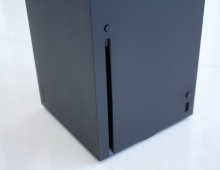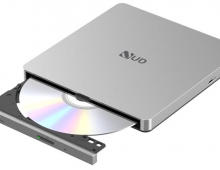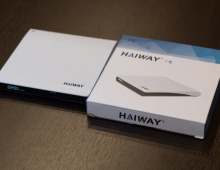
Hitachi Demos Four-Layer Blu-Ray Disc Playback
Hitachi showcased playback of a four-layer Blu-Ray disc featuring a capacity of 25GB per layer. The company said that the drive used for reading was a standard Blu-Ray drive, at its booth at the 2007 International CES.
There have been other academic reports of creating fourlayer (100GB) or even six layer (200GB) disc media by TDK. Some companies have also showcased playback of multi-layer BD media using test players embedded with a special optical head. But in the current demonstation, Hitachi used a 'standard drive'.
"This is the first demonstration of quadruple disc readout using a player based on an optical head generally used in current BD drives on the market," said Hitachi representatives.

Hitachi used an optical disc drive based on the "GBW-H10N" supporting 4x speed BD recording, which Hitachi-LG Data Storage, Inc. announced in July 2006. However, the company made some alterations to the firmware and the optical system inside the head, to make the player compatible with four-layer BD playback. Frontend signal processing (Renesas) and other circuits are the same as those used in the "GBW-H10N."
Of course, the demonstration did not include playback of video. Hitachi set up a reference system that included a PC, the BD drive connected to an oscilator, tuned to display the HF reading signal and especially the data patterns of the disc, which indicate the BD recording marks. According to a report on the Japanese Tech-On website, the first layer (L0) of the 100GB disc included a series of 3T patterns followed by 4T patterns marked on a layer one (L1) above it, 5T patterns on L2 and 6T patterns on L3. When the player picked up signals from each layer on this disc, it displays the signals' waveforms using the oscilloscope. The frequencies changed depending on the layer being read, so demonstration observers could recognize the readout of each layer. However, the drive was not set to pick up the 2T patterns, which are the smallest found on data Blu-Ray discs (3T to 11T for the data features on DVD).
Hitachi said, that developing this technology required a drive capable of detecting which layer to read. The company has not specified how the pickup lens actually detects the readout layer, but reportedly explored a wide variety of methods including a very basic way, in which the pickup lens finds a targeted layer by scanning each layer in order of shorter distance from the optical head.
Quadruple BD capacity could be used for storing Digital Cinema Picture Quality content in the future. For example, a 100GB disc could hold 3.5h hours of 64Mbps video (resolution 4K-2K).
"This is the first demonstration of quadruple disc readout using a player based on an optical head generally used in current BD drives on the market," said Hitachi representatives.

Hitachi used an optical disc drive based on the "GBW-H10N" supporting 4x speed BD recording, which Hitachi-LG Data Storage, Inc. announced in July 2006. However, the company made some alterations to the firmware and the optical system inside the head, to make the player compatible with four-layer BD playback. Frontend signal processing (Renesas) and other circuits are the same as those used in the "GBW-H10N."
Of course, the demonstration did not include playback of video. Hitachi set up a reference system that included a PC, the BD drive connected to an oscilator, tuned to display the HF reading signal and especially the data patterns of the disc, which indicate the BD recording marks. According to a report on the Japanese Tech-On website, the first layer (L0) of the 100GB disc included a series of 3T patterns followed by 4T patterns marked on a layer one (L1) above it, 5T patterns on L2 and 6T patterns on L3. When the player picked up signals from each layer on this disc, it displays the signals' waveforms using the oscilloscope. The frequencies changed depending on the layer being read, so demonstration observers could recognize the readout of each layer. However, the drive was not set to pick up the 2T patterns, which are the smallest found on data Blu-Ray discs (3T to 11T for the data features on DVD).
Hitachi said, that developing this technology required a drive capable of detecting which layer to read. The company has not specified how the pickup lens actually detects the readout layer, but reportedly explored a wide variety of methods including a very basic way, in which the pickup lens finds a targeted layer by scanning each layer in order of shorter distance from the optical head.
Quadruple BD capacity could be used for storing Digital Cinema Picture Quality content in the future. For example, a 100GB disc could hold 3.5h hours of 64Mbps video (resolution 4K-2K).





















